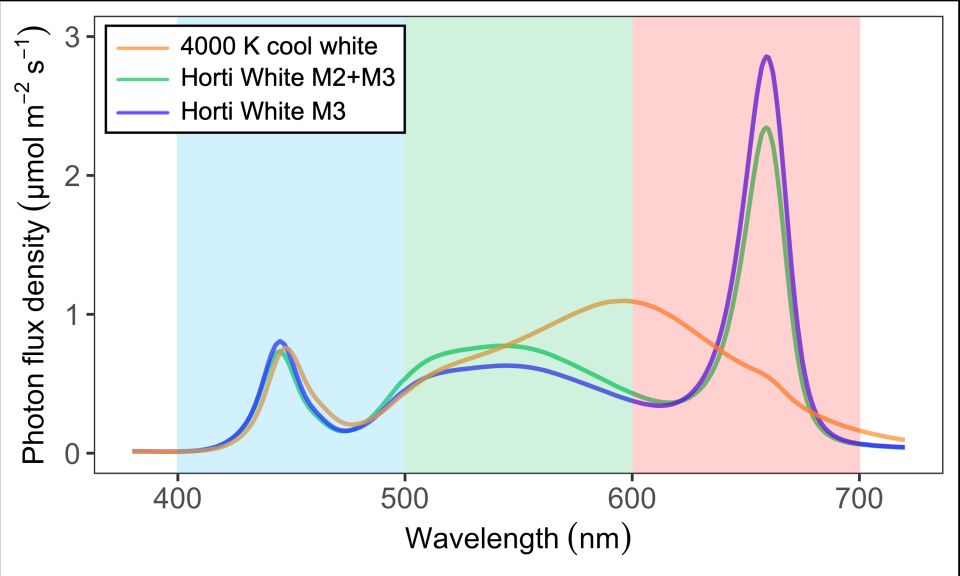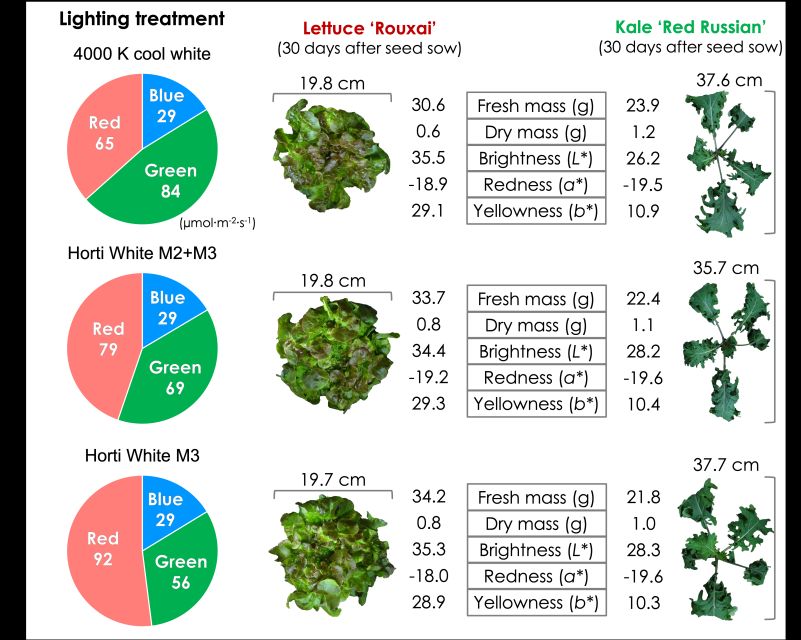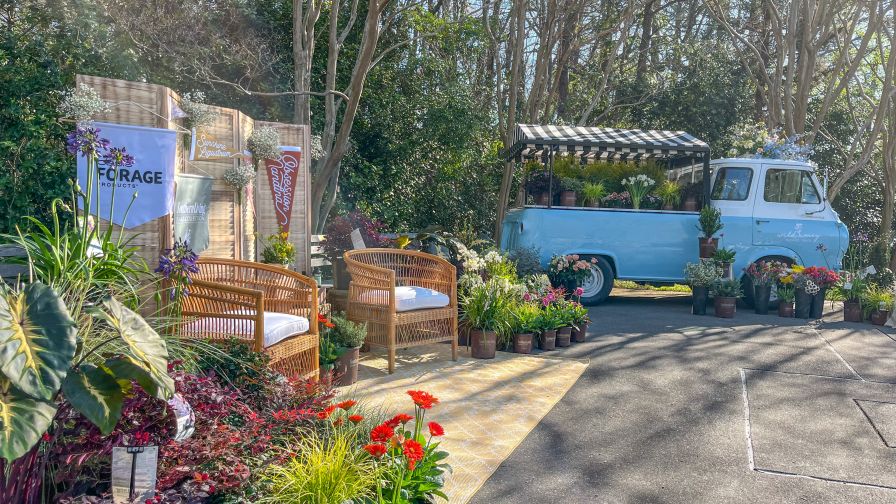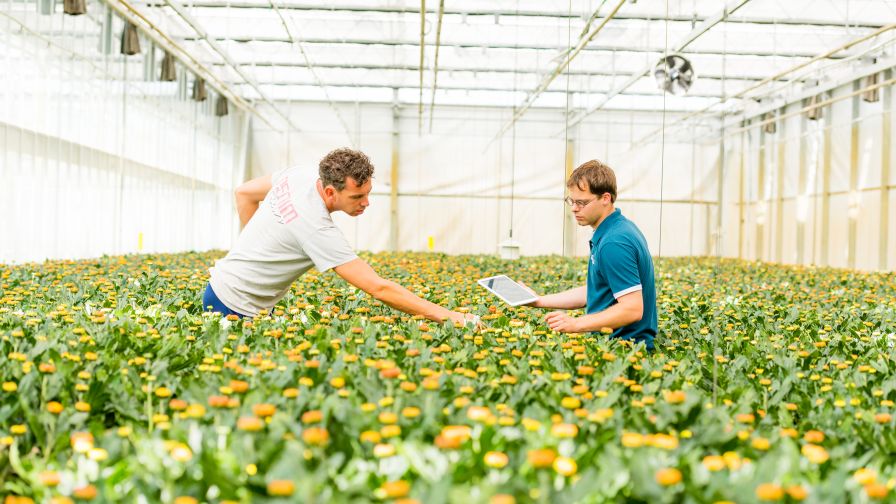A Closer Look at the Effect of White LEDs on Plant Performance

This graphic shows the photon spectra emitted by lighting fixtures that had red LEDs and 4000 K cool white, Horti White M2+M3, or Horti White M3 LEDs. Graphics: Erik Runkle
In indoor (vertical) farming, electric lighting plays a pivotal role in controlling crop productivity and quality. Electric lighting is also one of the largest operational costs of indoor farming, so fine-tuning the lighting environment has significant economic importance. Blue (400-500 nm) and red light (600-700 nm) are slightly more photosynthetically efficient than green (500-600 nm) light because of greater absorption by photosynthetic pigments within leaf tissue. Moreover, red light-emitting diodes (LEDs) have a higher photon flux efficiency than other types of common LEDs, such as blue or white LEDs. Therefore, it is necessary to optimize the lighting spectrum considering both crop growth and energy costs.
The indoor lighting spectrum can have a large impact on plant shape and leaf color. Blue light enhances pigmentation but generally inhibits leaf expansion and stem elongation. However, at least a modest percentage of blue light is needed for normal plant growth. Green light has less of an effect on morphology and coloration than blue light. Therefore, partially replacing green with red light may not have a noticeable change in crop growth and quality, but could increase energy efficiency.
There are many kinds of white LEDs on the market, which emit different percentages of blue, green, and red light. In this study, we evaluated the influence of light at the same total intensity (photon flux density, or PFD) using three different types of white LEDs, combined with light from red LEDs, while keeping the blue PFD constant. We selected lettuce and kale for evaluation because of their popularity as well as their sensitivity to the light spectrum. We hypothesized that plant growth and quality would be similar among the three lighting treatments if they all emitted the same percentage of blue light.
Experiment Protocol
Seeds of red oakleaf lettuce ‘Rouxai’ and kale ‘Red Russian’ were germinated at 73°F under continuous warm-white LED light at 180 µmol∙m-2∙s-1. Ten days after seed sow, seedlings were transplanted into a vertical deep-flow hydroponic system that contained deionized water supplemented with a water-soluble 12N-4P-16K fertilizer at an electrical conductivity of 1.8 dS∙m-1 and pH of 5.6. During this time, plants were grown indoors under three different experimental LED modules developed by ams OSRAM. The modules contained red LEDs (peak of 660 nm) and different types of white LEDs:
- 4000 K 80 CRI cool white (CW)
- Horti White M2+M3 (HW2+3)
- Horti White M3 (HW3)
The fixtures delivered an equal photosynthetic PFD (PPFD; 400-700 nm) of 177 µmol∙m-2∙s-1, and the same intensity of blue light, but emitted different proportions of green and red light. Most of the red light in the two Horti White treatments was from 640 to 670 nm, whereas the CW treatment had a broader waveband of red light. The lights operated for 20 hours per day. On day 30, we harvested ten randomly selected plants from each treatment, per cultivar, and quantified fresh and dry weight, plant diameter, and leaf coloration.

This graphic shows lighting treatments, representative plants, and growth and leaf coloration averages of lettuce ‘Rouxai’ and kale ‘Red Russian’ grown indoors under three lighting treatments.
Varied Lighting Produces Similar Results
Shoot fresh weight, dry weight, and shoot diameter of lettuce ‘Rouxai’ and kale ‘Red Russian’ were statistically similar under lighting treatments with HW2+3 (substitution of green with red light by 14 µmol∙m-2∙s-1) or HW3 (substitution of green with red light by 27 µmol∙m-2∙s-1) compared to CW LEDs. The growth and morphology of leafy greens depend highly on blue light, the PPFD, and far-red light. In this experiment, blue light and PPFD were kept constant, while green light was changed by replacement with red light using different white LEDs. This could be why there was no change in plant growth and morphology of either crop in this experiment. There was very little far-red light emitted by the fixtures and thus did not influence plant growth.
Lighting treatments with CW, HW2+3, or HW3 LEDs produced similarly colored lettuce and kale leaves, with statistically similar brightness, redness, and yellowness (Figure 2). Blue light stimulates pigment biosynthesis and increases red-leaf coloration in some plants. In this study, the leaf coloration of lettuce ‘Rouxai’ and kale ‘Red Russian’ were similar regardless of the lighting treatment because of the same intensity of blue light.
Cut Energy Use, Not Plant Quality
In this study, we partly substituted some of the red light from white LEDs with more efficient red LEDs, while keeping the blue light and PPFD constant. There was practically no effect on the growth and morphology of lettuce ‘Rouxai’ and kale ‘Red Russian’. Furthermore, there was no effect on the brightness, redness, and yellowness of the leaves. Using a Horti White-based solution enabled greater use of the most efficient red LEDs. This approach still delivered sufficient intensities of blue light while increasing fixture efficacy, thereby reducing energy consumption without sacrificing growth or quality.
Acknowledgments: We thank ams OSRAM for supporting this project.










